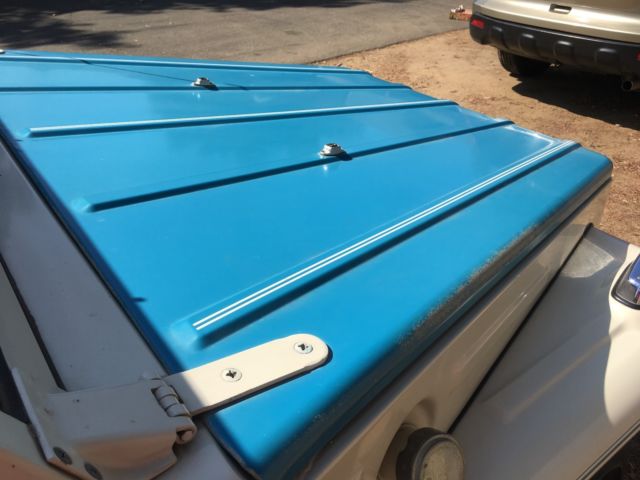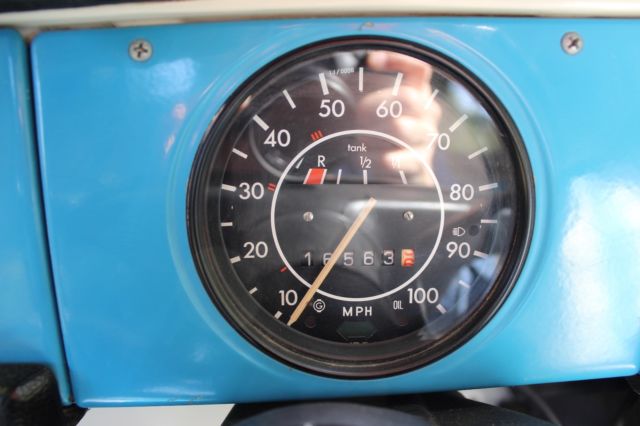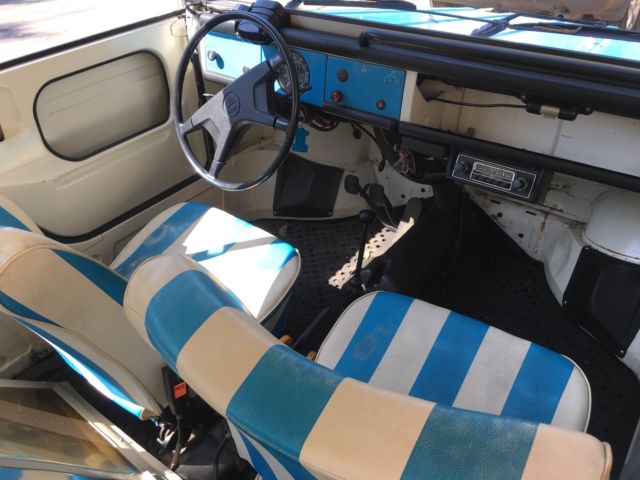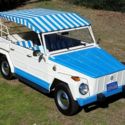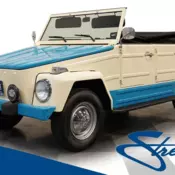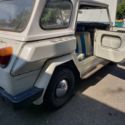1974 VW Thing "Acapulco" Edition ALL ORIGINAL * Low Miles, Clean & Runs*
| Make: | Volkswagen |
| Model: | Thing |
| Type: | Convertible |
| Year: | 1974 |
| Mileage: | 16,563 |
| VIN: | 1842544931 |
| Color: | White |
| Fuel: | Gasoline |
| Transmission: | Manual |
| Vehicle Title: | Clear |
| Item location: | Carmichael, California, United States |
1974 Volkswagen Thing Additional Info:
1974 VW Thing RARE "Acapulco" EditionCLEAN * ORIGINAL & RUNS GREAT!
Additional information:
* 16,563 miles
*Clean Title
* 2 owners total. This car was purchased by the current owner approx 1976 from a dealership in northern California
* 1 year ago the owner had a VW mechanic replace anything and everything that needed to be done to keep this in good running condition. Including all the hoses and seals were replaced, Brakes updated and engine had a full check up. the car has been parked in the garage since then
* Passenger side mirror in missing but can be replaced for aprox $89.00
* Original Rims
* Spare tire included but was replaced along the way
* This car is in original condition meaning it has never been repainted and has original factory upholster.
* This car comes with the original removable hard top and windows that can be on or off. The front windshield also folds down.
* Parked in covered garage never left outside
* Incredibly Clean and well maintained
To follow ALL my other Vintage & Antique Items Check out All my Stuff for Sale on Etsy, Facebook and Instagram at "Auburn Amy Fresh Picks"
More Information about the "Thing" Taken from Wikkipedia
TheVolkswagen Type 181is atwo-wheel drive, four-door,convertible, manufactured and marketed byVolkswagenfrom 1968 to 1983. Originally developed for theWest German Army, the Type 181 was also sold to the public, as theKurierwagenin West Germany, theTrekker(RHD Type 182) in the United Kingdom, theThingin the United States (1973–74), theSafariin Mexico and South America, andPescacciain Italy. Civilian sales ended after model year 1980.
Manufactured inWolfsburg, West Germany (1968–74),Hannover, West Germany (1974–83),Puebla, Mexico (1970–80), andJakarta, Indonesia (1973–80), the Type 181 shared its mechanicals with Volkswagen'sType 1(Beetle) and the pre-1968Volkswagen Microbus, its floor pan with the Type 1Karmann Ghia, and its concept with the company'sKübelwagen, which had been used by the German military duringWorld War II.
Contents[hide]- 1History
- 2Technology and performance
- 3See also
- 4References
- 5Further reading
- 6External links
| This articleneeds additional citations forverification.Please helpimprove this articlebyadding citations to reliable sources. Unsourced material may be challenged and removed.(April 2017)(Learn how and when to remove this template message) |
| This articlepossibly containsoriginal research.Pleaseimprove itbyverifyingthe claims made and addinginline citations. Statements consisting only of original research should be removed.(April 2017)(Learn how and when to remove this template message) |
During the 1960s, several European governments began cooperating on development of a vehicle known as theEuropa Jeep, a lightweight, amphibiousfour-wheel drivevehicle that could be mass-produced for use by various national military and government groups. Development of the vehicle proved time-consuming, however, and the West German government was in need of a limited number of light, inexpensive, durable transport vehicles that could fulfill their basic needs while the Europa Jeep was being developed and put into production.
Although Volkswagen had been approached during the 1950s about building such a vehicle, and had subsequently passed on the proposition, the then-current management of the company saw the project as having some amount of potential as a consumer vehicle; Mexican customers were asking for something that could handle rural roads better than the Type 1, which was a large seller in Mexico at the time, and the popularity of VW-baseddune buggieswithin the U.S. made executives think that a durable, fun, off-road-capable vehicle would become attractive to many buyers. VW could keep cost to a minimum and thus maximize profitability by using existing parts.
Like theWorld War IIeraType 82 Kübelwagen, the Type 181 used mechanical parts and a rear-engine platform,manual transmissionand aflat-4engine derived from that of the Type 1.
The floorpans came from the Type 1Karmann Ghia, which had a wider floorpan than the Beetle. Rear swing axle suspension with reduction gearing from the discontinued split-screenVolkswagen Transporterwas used until 1973, when it was replaced with double-jointed axles used by Porsche and IRS semi-trailing arm setup as used on the 1303 and US-spec Beetles.
Civilian sales began in mainland Europe and Mexico during 1971; in the U.S. in 1972; and briefly in Britain in 1975, where it failed to sell well and was dropped fairly quickly.
The model was dropped from the American lineup for 1975 as it failed to meet new, stricter US safety standards. The Type 181 was reclassified as a passenger vehicle, and thus subject to stricter safety standards. The Windshield Intrusion Rule of the 1975 DOT standard called for a greater distance between the front seat occupants and the front window glass.[2]
TheEuropa Jeepwas the result of aNATOplan to have a vehicle whereby each European NATO makers all combined to build a light-duty patrol vehicle.
The Volkswagen 181 was only supposed to fill in, until the time that the Europa Jeep was ready. From 1968 until 1979, over 50,000 Type 181s were delivered to the NATO forces. By 1979 the Europa Jeep project had fallen apart completely and was abandoned, and the West German government began supplementing their consumption of 181s with the new front-enginedType 183 Iltis.
Despite the West German government's switch to the Type 183, European and Mexican sales of the civilian 181 continued through 1980, and several organizations, including NATO, continued to purchase military-spec Type 181 units through 1983, finding their reliability and low purchase and maintenance costs attractive.





